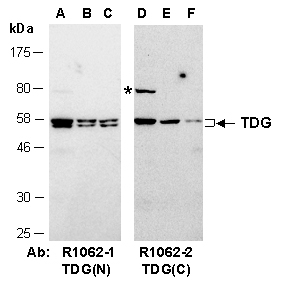Abiocode Logo
Products
Contact Us
- Telephone:
1-818-707-0309 - E-Mail:
Abiocode@Abiocode.com
R1062-1 - TDG (N) Antibody, Rabbit Polyclonal
|
Quantity: 100 ul Application: WB Predicted M.W.: 46 kDa Uniprot ID: Q13569 Background: G/T mismatch-specific thymine DNA glycosylase (TDG) belongs to the TDG/mug DNA glycosylase family. TDG removes thymine moieties from G/T mismatches by hydrolyzing the carbon-nitrogen bond between the sugar-phosphate backbone of DNA and the mispaired thymine. TDG also removes thymine from C/T and T/T mispairings with lower activity. In addition, TDG can remove uracil and 5-bromouracil from mispairings with guanine. TDG plays a central role in cellular defense against genetic mutation caused by the spontaneous deamination of 5-methylcytosine and cytosine. Other Names: G/T mismatch-specific thymine DNA glycosylase, Thymine-DNA glycosylase Source and Purity: Rabbit polyclonal antibodies were produced by immunizing animals with a GST-fusion protein containing the N-terminal region of human TDG. Antibodies were purified by affinity purification using immunogen. Storage Buffer and Condition: Supplied in 1 x PBS (pH 7.4), 100 ug/ml BSA, 40% Glycerol, 0.01% NaN3. Store at -20 °C. Stable for 6 months from date of receipt. Species Specificity: Human, Mouse Tested Applications: WB: 1:1,000-1:5,000 (detect endogenous protein*) *: The apparent protein size on WB may be different from the calculated M.W. due to modifications. Product Data:
|
